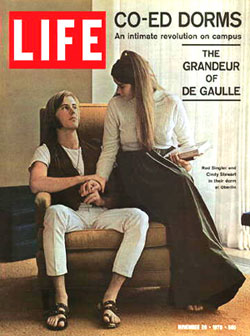An Intimate Campus Revolution
 The concept of coed residence halls might seem like an obvious fit for an institution that, in 1841, was the first to award degrees to women. Yet, the shift was radical considering that until the late 1960s, women at Oberlin College and at campuses across the country had to abide by curfews under the watchful eye of faculty. Visitation from their male counterparts was limited to 3-1/2 hours every Sunday, during which time their doors had to be open the width of a wastebasket. To allow the opposite sex in your door room, let alon`e the same building, was an alarming contrast to previous generations of college students.
The concept of coed residence halls might seem like an obvious fit for an institution that, in 1841, was the first to award degrees to women. Yet, the shift was radical considering that until the late 1960s, women at Oberlin College and at campuses across the country had to abide by curfews under the watchful eye of faculty. Visitation from their male counterparts was limited to 3-1/2 hours every Sunday, during which time their doors had to be open the width of a wastebasket. To allow the opposite sex in your door room, let alon`e the same building, was an alarming contrast to previous generations of college students.
For years, a moral code kept women and men carefully segregated on campus as a means to avoid any distraction from academic performance. In the 19th century, interaction among Oberlin’s male and female students was limited to classes and eating at the same tables. In the 1930s, a “drastic change” occurred when men and women could sit next to each other in the chapel. College officials strategically choreographed students’ living and social arrangements. Women’s housing units were zoned exclusively south of College Avenue, while men’s housing units were on the north end of campus.
Amid the social and political changes of the ’60s, students started a revolt against the in loco parentis community model, which empowered faculty to serve as parents to students. By 1968, Oberlin’s faculty yielded its bylaw to govern student life in loco parentis, and College officials adopted an open dorm policy. A year later students and administrators agreed to create several coeducation residence halls after reviewing similar housing models at Stanford and Michigan universities, although those schools allowed men and women to live in alternate rooms on the same floors.
Oberlin’s decision to create coed living and 24-hour visiting became famous by the November 20, 1970, issue of Life magazine. The article, “Co-ed Dorms: An Intimate Campus Revolution,” featured Oberlin students Rod Singler, a junior, and Cindy Stewart, a freshman. The two lived in the same dorm and developed a close personal relationship.
According to the article, “Such revolutionary departures in living arrangements are startling to middle-age parents, whose own experience was the traditionally strict segregation of sexes and limited visiting hours clocked by campus cops and housemothers.
“At Oberlin, the absence of traditional restraints has encouraged an ease and naturalness enthusiastically endorsed by students and faculty.”
Psychologists of the day concluded that coed living helped alleviate tensions between the sexes. In essence, men could relate to women as friends rather than as sexual objects.
Oberlin’s Dean of Women Rose Montague gave coed living arrangements a positive endorsement in Life: “It’s so exciting now on campus. The students have a chance to grow as persons, not just academically.”
Today, Oberlin continues to break down the gender divide by allowing men and women to share the same dorm room. Oberlin is part of a growing movement among colleges adopting a gender-neutral housing policy that seeks to be more inclusive.
Sources: Oberlin College archives; Oberlin College LGBT Community History Project; Life magazine, Geoffrey Blodgett’s Oberlin History (2006); Oberlin Review; The Boston Globe